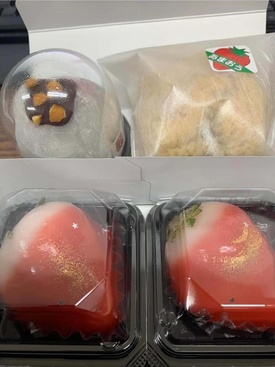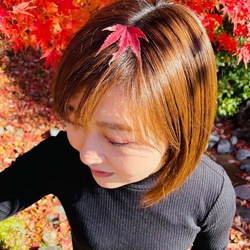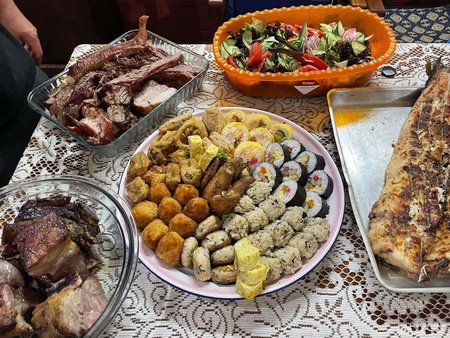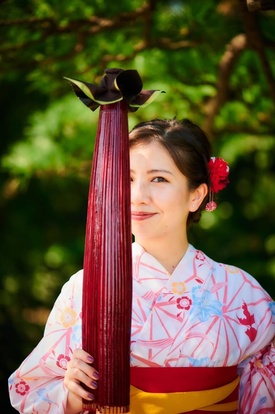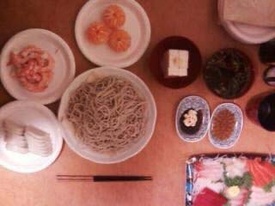There’s something traditional about traditions, and for folks who have grown up and have had direct experience with Japanese culture, following a subset of these traditions are atarimae (normal). However, there’s lots of people who may not have had the same exposure to these traditions—such as Nikkei living in Japan.
There are a lot of Nikkei who live in Japan—next to Brazil and the US, the largest population of Nikkei is actually in Japan. So, what do New Year’s traditions look like for Nikkei who are living in Japan? I asked a few to find out.
“When I first got to Japan, I got very homesick my first New Year. I remember spending it with my friend from Mexico,” says Miwa, a Nikkei Sansei.
Back in Paraguay, her grandparents would follow all the customs and traditions—pounding mochi, making ozoni7, eating osechi. It wasn’t exactly like Japan, but they made it with whatever they could get their hands on.
Miwa has been in Japan for five years now, the first few as a student. Growing up in Paraguay, she didn’t take up many of her parents’ traditions, preferring to go to New Year’s parties dressed in white. While Miwa’s student years in Japan were quite untraditional (with the exception of the occasional ozoni), after graduating, her Japanese boyfriend’s family does haka-mairi8 and osechi, and Miwa seems comfortable participating in these familiar traditions. “I went to my boyfriend’s parents’ house, and ate a lot,” she laughingly laments.
“I usually work!” says Myho, a Brazilian Nikkei. Not having any traditions, the New Year was a great time to get seasonal holiday pay. “One year, I tried to do hatsumode9, but I didn’t like it, because it was too crowded and I didn’t feel a connection with it. I got married this year, and for the first time, I’m going to my (Japanese) husband’s house, but I still don’t know what it will look like. He says that his mother cooks osechi and it will be very traditional, but it will be my first time doing a traditional Oshogatsu.” She flashes a bashful grin. “They are very traditional, but they also know that I’m from another country, so they’re not expecting me to behave traditionally.”
Myho’s Issei father immigrated to Brazil after the war, and eventually moved back to Japan as dekasegi10, taking Myho and her native Brazilian mother with him. Myho was six at the time, and has spent most of her life in Japan. Growing up with only her mother, there was no Japanese presence at home to impart Japanese culture—not that her father was very traditional to begin with.
“The first time I even knew the concept of osechi ryori was when I was working at a seasonal job at a factory for 7-11. I actually made osechi as part of the factory—salmon sashimi rose and kuri-kinton11. I did this for a few seasons in late high school and early university.”
Understandably, her New Year’s traditions are apparently Brazilian traditions—eating grapes, and having the first step after midnight be made with the right foot—but she’s not actually sure. She does have one more tradition—oosoji12, but this is common to many cultures, she says.
Myho’s father did not maintain very much in the way of tradition, so Myho today considers herself very untraditional, even though she has lived in Japan for a much greater portion of her life than myself or Miwa. “Sometimes, I feel like Japanese traditions are mendokusai (burdensome),” she says.
Finally, my own traditions. My first year in Japan looked a lot like Miwa’s—it was a very lonely New Year. I remember buying only the parts of osechi that I liked to eat, and making toshikoshi soba13 and ozoni, patterned from childhood memories.
Eventually, I married a Japanese woman, and started following the traditions that my wife’s family has. In addition to the standard soba/ozoni/osechi type of thing, one of the more interesting traditions we have is to trim our fingernails before the new year. Apparently there is even a ukiyo-e of this practice, so it’s been around for at least a few hundred years.
Interestingly, all the Nikkei that I talked to have partners that are Japanese born and raised. And clearly, family has a large influence on the traditions that we choose to adopt. But, there’s something about just being here as well—I had a friend tell me that “seeing all the traditions in Japan made me want to connect with my Chinese culture more, so I started making dumplings during the new year.”
One of the perks though, of being Nikkei, is that you get to invent your own traditions. You can mix and match, and choose the parts of each culture that you want to keep. And while I’m not Paraguayan, asado on new years sounds delicious. And I think I’ll start eating grapes, as well.
At the end of the day, traditions are inherently personal, and we get to choose what traditions we keep. And they don’t have to be your traditions, or even the traditions of your inherited family. And whether the traditions are newly inherited, freshly adopted, or have gone on for generations—just like whether you’re first generation or tenth, you’re still Nikkei—that doesn’t detract from the meaning of that tradition, as long as it means something important to you.
Happy Holidays, and 明けましておめでとう!
Notes:
1. Hanami: a cherry blossom viewing party.
2. Unagi: eel. There is a custom of eating eel through Japan’s hot summer days.
3. Kumade: bamboo rake. Kumade is a lucky charm for a good harvest. They also represent “raking in” heaps of success, wealth, and good luck. Decorative kumade can be found in Japan during the fall and even New Year. Ref: Kazari Kumade (Japan Travel); Japanese Kumade: Rake In Luck And Good Fortune (Wondeland Japan WAttention)
4. Osechi: New Year dishes
5. Suika Bar: Watermelon popsicle
6. Ichigo daifuku: A variation containing strawberry and sweet filling, most commonly anko, inside a small round mochi. (Wikipedia.com)
7. Ozoni: mochi soup
8. Haka-mairi: visit a grave
9. Hatsumode: first shrine or temple visit of the new year to appreciate the last year’s health and happiness and to pray for another good year.
10. Dekasegi: a migrant worker, especially here, Japanese descendants from Latin American countries who have migrated to Japan to work short-time in Japan. Many Nikkei, however, decided to permanently settle in Japan.
11. Kuri-kinton: mashed sweet potato with sweet chestnuts, which symbolize economic fortune and wealth.
12. Oosoji: major cleanup at the end of the year.
13. Toshikoshi soba: soba, buckwheat noodles, before midnight on New Year’s Eve to pray for bringing long life and prosperity in the year ahead.
References
Ukiyoe tsumekiri: 七草爪・七種爪 (Nanakusazume)
© 2023 Mike Omoto


